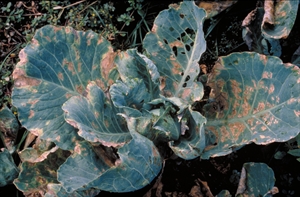Cabbage downy mildew
Pacific Pests, Pathogens, Weeds & Pesticides - Online edition
Pacific Pests, Pathogens, Weeds & Pesticides
Cabbage downy mildew (192)
Hyaloperonospora parasitica; previously known as Peronospora parasitica. There are different strains of the Oomycete such that the strain on radish does little damage to cabbage.
Asia, Africa, North, Central America, the Caribbean, Europe, Oceania. It is recorded from Australia, American Samoa, Fiji. French Polynesia, New Caledonia, New Zealand, Papua New Guinea, and Samoa.
Members of the brassica family, e.g., cabbage, cauliflower, broccoli, Chinese cabbage, and many more. It also infects weeds (e.g., shepherd's purse) and some ornamentals (e.g., wallflower) in the brassica family.
The disease is caused by an oomycete or water mould, not a fungus. Although they look like fungi, downy mildews are related to algae.
Attacks are more common in seedbeds. Under wet conditions favourable for the disease, yellow to pale brown spots develop rapidly into large irregular patches, on the upper surface of the young leaves. A greyish white growth occurs on the underside of the leaves, and may be present, too, on the upper surface during cool and moist conditions. The infected areas turn brown and papery in dry weather. Severely affected seedlings are stunted and killed. The older leaves may have a speckled appearance (Photo 1).
Similar symptoms appear in the field and lead to early death of the leaves; in moist weather the spots grow larger, join together and form large dead patches (Photo 2). The infections can lead to bacterial rots developing in storage. Large dark brown rots develop on cauliflower heads.
The Oomycete spreads in wind and water. Long distance spread occurs on seedlings, and also there is evidence for spread as spores on seed. The disease does best when there is high humidity, fog, drizzling rains, and heavy dew. Leaf wetness of 4-6 hours at 20°C and 6-8 hours at 15°C are necessary for significant infection and development of downy mildew.
Survival of the oomycete is on self-sown ('volunteer') brassica plants, and also on weeds. Survival is also possible in soil and plant remains as thick-walled spores known as oospores, which are produced through a sexual process.
Downy mildew of cabbage and other brassicas is not an important disease in the tropics as much as it is in the sub-tropics and temperate climates. Seedlings, especially if overcrowded, are more usually affected by the disease. Severely affected seedlings may die. Occasionally, severe outbreaks are reported. Downy mildew is more important on the crops used for flower heads, e.g., broccoli and cauliflower, than those used for leaves, e.g., cabbage, and least damaging on those used for roots, e.g., turnip.
Look for yellow patches on the cotyledons and young leaves, with white growth on the underside. Look for the spore-bearing structures within the white growth with a hand lens.
CULTURAL CONTROL
Before planting:
- Keep nurseries free from weeds, especially those in the cabbage family.
- Water plants early in the day so that leaves are wet only for a few hours, not long enough for downy mildew spore to germinate and infect.
- Avoid overcrowding seedlings so that there is sufficient air movement around them.
- Carefully check each seedling before transplanting in the field, and remove any that show downy mildew symptoms. If symptoms are seen, spray all the seedlings with a systemic fungicide.
During growth:
- Remove weeds in the brassica family that may be alternative hosts of downy mildew.
After harvest:
- Practice crop rotation, with non-brassica species.
- Collect and burn or bury as much of the crop as possible when harvest is complete.
CHEMICAL CONTROL
Use fungicides on seedlings, but to increase their effect keep humidity and leaf wetness low (see above). If fungicides are needed, spray with systemic metalaxyl, or protectant mancozeb, copper or chlorothalonil.
____________________
When using a pesticide, always wear protective clothing and follow the instructions on the product label, such as dosage, timing of application, and pre-harvest interval. Recommendations will vary with the crop and system of cultivation. Expert advice on the most appropriate pesticides to use should always be sought from local agricultural authorities.
AUTHOR Grahame Jackson
Photo 1 Diseases of vegetable crops in Australia (2010). Editors, Denis Persley, et al. CSIRO Publishing; and from CABI (2019) Hyaloperonospora parasitica (downy mildew). Crop Protection Comppendium. (https://www.cabi.org/cpc/datasheet/39723). Photo 2 Kohler F, et al. (1997) Diseases of cultivated crops in Pacific Island countries. South Pacific Commission. Pirie Printers Pty Limited, Canberra, Australia.
Produced with support from the Australian Centre for International Agricultural Research under project PC/2010/090: Strengthening integrated crop management research in the Pacific Islands in support of sustainable intensification of high-value crop production, implemented by the University of Queensland and the Secretariat of the Pacific Community.





